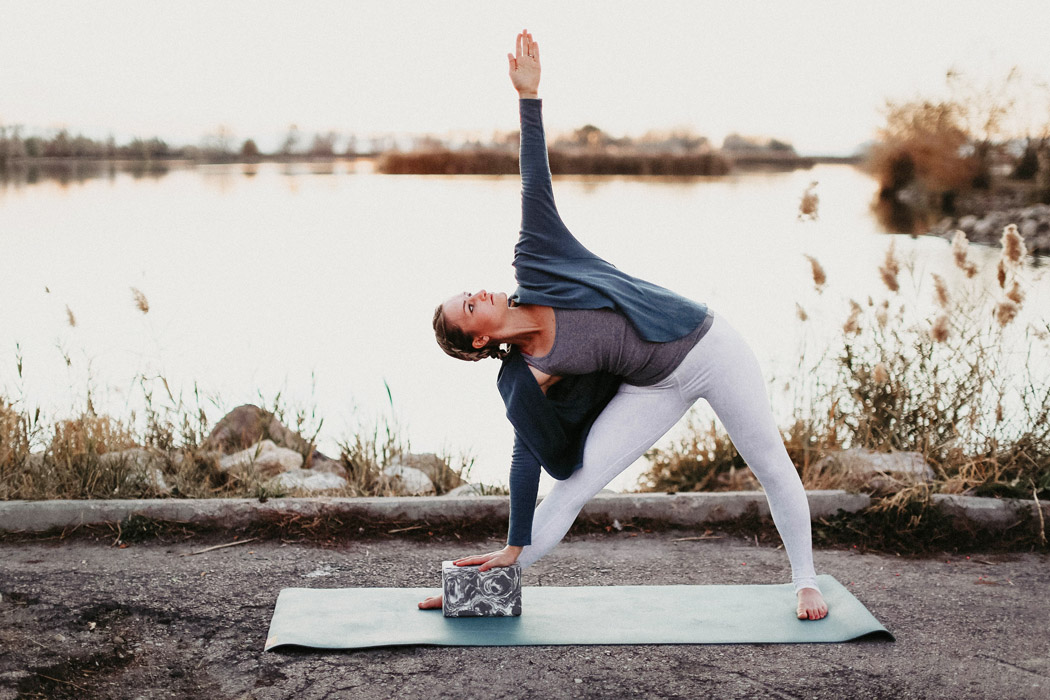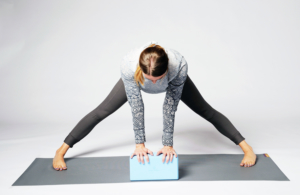
The first time I used Yoga Blocks 30-some years ago I can’t say I loved the experience. The blocks were very heavy—solid pine—and had sharp edges that dug into my skin. They were also very slippery. The chances of dropping them on toes—and causing significant damage—were high. Plus my ego resisted using something I thought of back then as a crutch.
All that has changed. My small studio has 50 Yoga Blocks stored in its prop room, blocks of many different kinds, to fit the preferences of my students. I love my blocks, and so do my students. Together we’ve discovered so many ways to use them.
The best news is that blocks are far more comfortable than they once were. All of Hugger Mugger’s blocks have rounded or beveled edges and the materials used are much easier on our skin and bones than the pine blocks of the past. And there are lots of choices now: heavy and light, large and small. All of Hugger Mugger’s blocks are designed to be sturdy and stable, and to last a very long time. Many of the blocks in my studio are “vintage”—some dating back to the early 1990s—and they’re still going strong.
How to Use Yoga Blocks
The uses of blocks are so vast and varied that one blog post can’t possibly touch on all of them. Our Prop Guide provides a good starting point. Or check out the posts in this blog under the heading of “How to Use Yoga Blocks.”
Blocks help us maintain anatomical integrity in poses. Placing your hand on a block in standing poses such as Trikonasana (Triangle Pose) or Parsvakonasana (Side Angle Pose) can make the difference between a pose that feels strained and uncomfortable, and a pose that feels free and graceful.
If the practice of yoga is about steadying the mind and body, then breathing freely and feeling a sense of ease in your poses is essential to practice. Yoga Blocks, more than any other yoga prop, help us realize the most important aim of practice.
Blocks are also essential tools for Restorative Yoga practice. In Supta Baddhakonasana (Reclining Bound Angle Pose), for example, blocks placed under the head end of the Yoga Bolster orients the bolster on a slant, allowing for a more neutral, relaxed spine.
How to Choose Yoga Blocks for Your Practice
Stability
Hugger Mugger uses high-quality materials in the construction of all our blocks. Even the least expensive blocks—3-inch and 4-inch foam—are much less squishy than what you’ll find in other brands. (I teach at an institution that has cheaper blocks in their prop closet, and I generally won’t use them for certain poses—especially standing poses—for fear that they’ll collapse to the side. I never have the same trepidation about Hugger Mugger’s Foam Yoga Blocks.) If stability is your most important concern, try these Yoga Blocks:
Wood Yoga Block, Bamboo Yoga Block, Cork Yoga Block, Recycled Foam Yoga Block, Marbled Foam Yoga Block, 4-Inch Foam Yoga Block, Big Foam Yoga Block
Weight
Lightweight blocks are easy to transport from home to studio. This is especially important for teachers who bring their own props to the venues where they teach. There’s a huge difference in weight between a box full of Wood Yoga Blocks and a box full of Foam Yoga Blocks. In the studio, lightweight blocks can be a plus too. When a student accidentally drops a Foam Yoga Block, it just bounces on the floor. Except for the Big Block, which weighs only 1.25 pounds, all these blocks weigh less than a pound:
3-Inch Foam Yoga Block, 4-Inch Foam Yoga Block, Recycled Foam Yoga Block, Marbled Foam Yoga Block, Big Foam Yoga Block
Some people prefer the heavier weight of wood and cork blocks. I keep some heavier blocks in my studio for students who prefer blocks with a more substantial feel. I often use Cork, Bamboo and Wood Yoga Blocks in my home practice, although I like the softness of Foam Yoga Blocks for some uses. Cork, Bamboo and Wood Yoga Blocks work well in a studio situation where the props have a permanent storage space.
Hugger Mugger’s Wood, Bamboo and Cork Yoga Blocks have rounded edges. The Wood and Bamboo blocks gave hollow centers to reduce their weight. Here are the blocks that weigh approximately two pounds:
Wood Yoga Block (2 pounds), Bamboo Yoga Block (2.2 pounds), Cork Yoga Block (1.85 pounds)
Sustainability
All of Hugger Mugger’s blocks are made from sustainable materials. Here’s a rundown of the materials we use in our blocks, and their sustainable qualities. All Hugger Mugger’s Yoga Blocks are non-toxic and recyclable.
EVA Foam: 3-Inch, 4-Inch, Marbled Foam, Big Foam Yoga Blocks. EVA foam is a non-toxic, recyclable material commonly used in the sports industry, including as padding in ski boots, foot beds of shoes, and costumes for kids and adults.
Recycled Foam: Recycled Foam Yoga Blocks. Recycled agricultural plastic sheeting that’s used as mulch for growing crops is the foundation of our Recycled Foam Blocks.
Cork: Cork Yoga Blocks. Harvested from the bark of the Cork Oak tree, cork is solid, impermeable, stable and recyclable. Cork trees continue to grow even after their bark has been harvested. Cork trees can live up to 200 years. The cork oak grows only in seven Mediterranean countries—Portugal, Italy, Spain, France, Algeria, Morocco, and Tunisia. Over 300,000 tons are harvested (stripped) each year and more than 100,000 people are employed in cork harvesting. The cork surface has natural friction. This makes it easy to remain stable when you use these blocks under your hands. These blocks are exceptionally popular!
Bamboo: Bamboo Yoga Blocks. Bamboo is a fast-growing, easily replenished, exceptionally hard and sturdy type of wood.
Wood: Wood Yoga Blocks. HM’s Wood blocks are locally handcrafted in Salt Lake City from Baltic Birch plywood. They are finished with a silky hand-rubbed beeswax finish.
Size
Yoga practitioners come in all shapes and sizes, so it’s important that blocks also come in sizes that accommodate everyone. Here are the advantages of the various sizes of HM’s blocks:
3-Inch Foam Yoga Blocks: At 3″ x 6″ x 9,” these 3-Inch Yoga Blocks are great for practitioners with smaller frames. The 4-Inch Foam Blocks are too wide for some people’s frames, especially when using them as a spacer between the thighs in Utkatasana (Fierce Pose) and Tadasana (Mountain Pose). It’s nice to have some of these at your studio as an option for smaller-framed practitioners. They’re also useful in Restorative Yoga, where more height options are really helpful for customizing the practice. These blocks are the most economical choice available.
4-Inch Foam, Marbled Foam, Recycled Foam, Cork, Bamboo, Wood Yoga Blocks: For general use, 4-Inch Yoga Blocks are the standard. The dimensions (4″ x 6″ x 9″) have been found to be the most universally useful for average practitioners. These blocks are studio staples.
Big Blocks: These oversized Big Yoga Blocks (5″ x 12″ x 6.75″) are great for bigger and taller practitioners. For some people more traditional-sized blocks are just not tall enough. But their uses are not limited to taller people. Even flexible people can benefit from using a bigger block. The person in the photo above is quite flexible. She’s using the Big Block to promote a neutral spine and deep breathing in Prasarita Padottanasana (Wide-Legged Forward Bend). These large, stable, lightweight blocks are wider all around so that even when they’re placed on end, they won’t topple over.
Price
All of Hugger Mugger’s blocks are designed to give many years of use. The blocks at my studio have been heavily used by lots of people over the past 20-plus years and haven’t lost a bit of their function. Considering that you won’t likely have to replace your blocks anytime soon, all of the choices are economical over time. Still, many new practitioners may want to make a smaller investment to start with. The guide below gives you a quick reference for the pricing of HM’s blocks:
$16.95 and under: 3-Inch Foam Yoga Block, 4-Inch Foam Yoga Block, Marbled Foam Yoga Block
$18.95-$24.95: Cork, Recycled Foam, Big Foam Yoga Blocks
$27.95: Bamboo Yoga Block
$39.95: Wood Yoga Block
We’d love to hear your ideas about how you use your blocks. Feel free to leave a comment!

